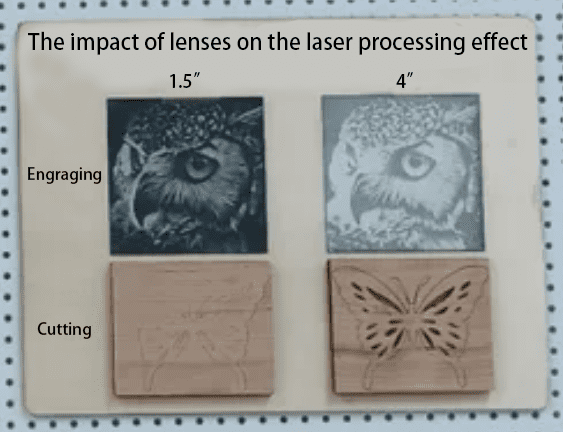How to choose lenses for laser processing?
What are the common types of lenses used in laser processing?
How to distinguish between different lens models?
What impact does it have on the processing effect?
Correctly selecting the appropriate lens model is key to achieving the desired laser processing effect. Generally, the 1.5″ lens has a smaller focal length, making it more suitable for engraving highly detailed high-resolution photos; the 2″ lens balances detail and uniformity in engraving, making it the most versatile for engraving most materials. The 2.5″ lens is very suitable for solving uneven large-area engraving issues on heat-sensitive materials like plastics. Because the 2.5″ lens has a larger spot size, it can prevent too much heat concentration at the focal point, reducing material warping during processing, while not affecting the engraving precision too much.
The smaller the lens focal length, the smaller the spot size at the focal point, and the smaller spot can achieve finer detail engraving at the same parameters, making photo engraving clearer. However, when engraving larger areas, the pattern may show very obvious lines. This is because the small spot leads to non-overlapping lens output. This may result in slightly rough picture engraving effects, and uneven whitening when engraving acrylic. Defocusing can increase the laser spot size on the material surface without changing the lens to achieve more uniform engraving.
The larger the lens focal length, the larger the spot size at the focal point, the deeper the depth of focus, and the stronger the penetration ability. Therefore, using a lens with a longer focal length can cut through thicker materials. For materials thicker than 10mm, we recommend using a 4.0″ lens for cutting.
How to use the correct lens based on application scenarios?
●To cut through thicker materials, use a lens with a longer focal length;
●To achieve finer engraved image quality, use a lens with a shorter focal length.
Impact of lenses on engraving/cutting effect:

What precautions are needed when changing lenses?
When changing lenses, note the following:
Pay attention to operational safety, do not fire the laser or move the laser head when changing lenses to avoid personal injury;
For the NOVA series, ensure no debris on the honeycomb platform when changing lenses. If necessary, lower the platform to prevent collisions and damage to the machine, materials or products during lens changes.
When changing lenses on the ODIN series, you can place a cloth on the honeycomb platform to avoid screws or other parts falling into the platform gaps accidentally during disassembly and assembly.

.png) International
International
 United States
United States
 Brasil
Brasil
 Canada
Canada
 Costa Rica
Costa Rica
 Česká
Česká
 Ελλάδα
Ελλάδα
 Polska
Polska
 Ireland
Ireland
 Portugal
Portugal
 Lietuva
Lietuva
 Россия
Россия Deutschland
Deutschland
 Britain
Britain
 Україна
Україна
 France
France
 Sverige
Sverige
 Italia
Italia
 Norway
Norway
 Denmark
Denmark
 Romania
Romania
 한국
한국
 中国
中国
 ประเทศไทย
ประเทศไทย
 中国香港
中国香港
 Israel
Israel
 中國臺灣
中國臺灣
 India
India
 پاکستان
پاکستان
 پශ්රී ලංකා
پශ්රී ලංකා
 ジャパン
ジャパン
 Australia
Australia
 New Zealand
New Zealand
 South Africa
South Africa